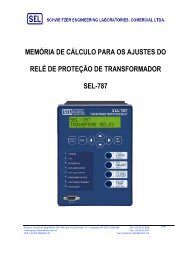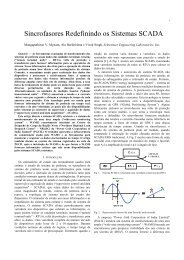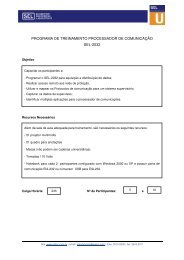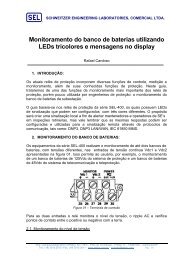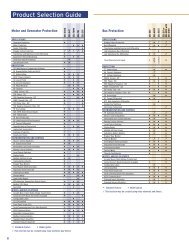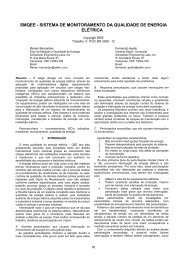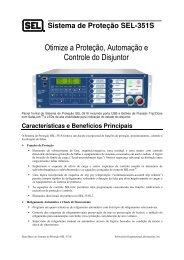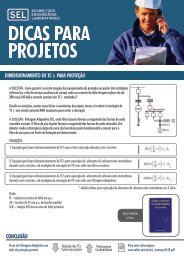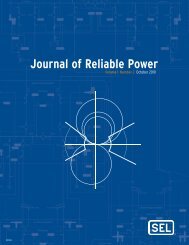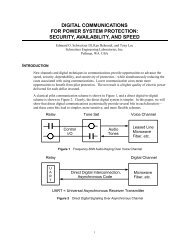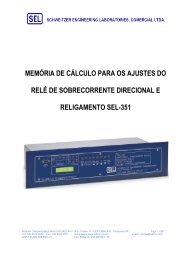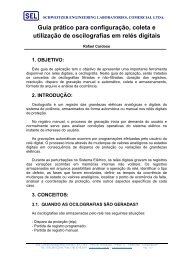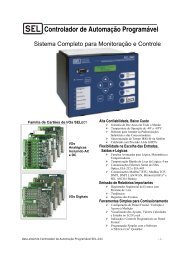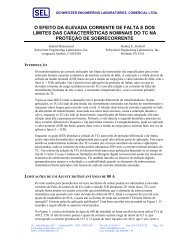Journal of Reliable Power - SEL
Journal of Reliable Power - SEL
Journal of Reliable Power - SEL
You also want an ePaper? Increase the reach of your titles
YUMPU automatically turns print PDFs into web optimized ePapers that Google loves.
6<br />
Fig. 11 shows the adaptive behavior <strong>of</strong> the reactance line<br />
derived from (4) and (5). Calculating a proper homogeneity<br />
angle tilt (denoted by T in the equation), the unit ensures<br />
correct reach regardless <strong>of</strong> the direction <strong>of</strong> the load flow.<br />
Similarly, Equations (13) and (14) define the adaptive<br />
phase resistance element for phase faults.<br />
S1 = (VRB − VRC) − Rset(IRB − IRC) (13)<br />
j L1<br />
S2 = (IRB2 − IRC2) e θ<br />
(14)<br />
jX<br />
ZL<br />
Fig. 11.<br />
Adaptive ground reactance element characteristic<br />
For ground distance elements, I0 is another choice for<br />
polarizing the reactance element. This option is acceptable if<br />
the homogeneity factor, T, for the zero-sequence impedances<br />
is known.<br />
For phase distance elements, using the negative-sequence<br />
current is also an option.<br />
S1 = (VRB − VRC) − Zset(IRB − IRC) (7)<br />
jT<br />
S2 = j(IRB2 − IRC2)e<br />
(8)<br />
The resulting a and b vectors are shown in (9) and (10).<br />
a = Zset<br />
(9)<br />
⎛ ⎛ IB1− IC1 ⎞⎞<br />
− j ⎜90− T+ ang ⎜1+<br />
⎟⎟<br />
⎝ ⎝ IB2 − IC2 ⎠⎠<br />
b = ∞ e<br />
(10)<br />
As described in [9], vector b defines the infinite diameter<br />
and the tilt angle, both <strong>of</strong> which are expressed in (5) for the<br />
ground reactance line and (10) for the phase reactance line.<br />
The resulting line is adaptive to the load flow direction, as<br />
shown in Fig. 11. The reactance line adapts properly to load<br />
flow and Rf.<br />
B. Adaptive Resistance Element<br />
Fig. 9 shows that the right resistance element is responsible<br />
for the resistive coverage in a quadrilateral distance element.<br />
This component <strong>of</strong> the quadrilateral distance element should<br />
accommodate and detect as much Rf as possible.<br />
In proposing an adaptive resistance line, it is possible to<br />
make the line static or adaptive as the reactance line. An<br />
adaptive resistive blinder is obtained by defining Rset in (2)<br />
and shifting (3) by (θL1 – 90°), where θL1 is the angle <strong>of</strong> the<br />
positive-sequence line impedance. The benefit shown in<br />
Fig. 12 is a shift <strong>of</strong> the resistance element to the right, which<br />
accommodates faults with forward load flow. Equations (11)<br />
and (12) implement the adaptive ground resistance element.<br />
S1 = VRA − Rset(IRA + k0 3I0) (11)<br />
j L1<br />
S2 = IR2 e θ<br />
(12)<br />
Rset<br />
Fig. 12. Adaptive ground resistance element characteristic<br />
While the use <strong>of</strong> negative-sequence current yields a<br />
beneficial tilt <strong>of</strong> the resistance element for load in the forward<br />
direction, as shown in Fig. 12, the tilt is in the opposite<br />
direction for load in the reverse direction. Therefore, the tilt is<br />
not beneficial under this condition.<br />
Additional polarizing options, like that the alpha<br />
component (I1 + I2) for ground and I1 for phase distance<br />
elements, yield satisfactory tilt behavior for reverse load flow.<br />
The reverse load flow behavior is the same.<br />
C. Left Resistance Element<br />
The left resistive line in Fig. 9 is responsible for limiting<br />
the operation <strong>of</strong> the quadrilateral element for reverse load<br />
flow. It does not need to be adaptive. Care has been taken not<br />
to include the origin to ensure satisfactory operation for very<br />
reactive lines.<br />
D. High-Speed Implementation<br />
In many transmission line protection applications, subcycle<br />
operation is required for distance elements. In many relays,<br />
distance elements with mho or quadrilateral characteristics are<br />
available. When the distance elements selected have<br />
quadrilateral characteristics only, the same high-speed<br />
requirement is applicable for faults with low-resistance value.<br />
In order to obtain subcycle operation with quadrilateral<br />
elements, the same dual-filter concept presented in [14] for<br />
mho elements is used here. The basic principle is to process<br />
the same distance function twice, using two types <strong>of</strong> voltage<br />
and current phasors: the function is processed first using halfcycle<br />
(high-speed) filter phasors and a second time with fullcycle<br />
(conventional) filter phasors. The final function state is<br />
obtained by the logical OR operation from the two processes.<br />
For single-pole tripping applications, these three ground<br />
distance elements (AG, BG, and CG) need to be supervised<br />
with a faulted phase selection function.<br />
R<br />
70 | <strong>Journal</strong> <strong>of</strong> <strong>Reliable</strong> <strong>Power</strong>



